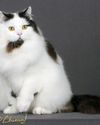Defining Breed Differences IN 3D
April 2020
|Cat Talk
We cat aficionados know about the fabulous variety of cat breeds—just compare a Siamese to a Persian, or a Singapura to a Maine Coon. But to most of the world—and I’m sorry to mention the D-word in CatTalk—it is dogs that are the kings of diversity; cats are thought to all be much the same, except for superficial differences in coat color and length. The great variety of dogs is backed up by scientific research showing that the variation in head shape among dog breeds far outstrips the differences among wild canid species, such as wolves and foxes.

No comparable study has been conducted on cats, however. A colleague of mine, Duncan Irschick, who is a professor at the University of Massachusetts, Amherst, and I decided to remedy this situation. Specifically, our plan was to precisely determine the variability in cat heads to compare to the variation seen among dog breeds and wild species of felines like lions, tigers, and ocelots.
The research is not just about bragging rights. Now that the housecat genome has been sequenced, it will soon be possible to discover the genes responsible for differences among breeds. But to do such studies, exact measurements of anatomy are required. Qualitative terms like “wedge” and “egg-shaped” are fine for breed standards, but more precision is needed to detect the relationships between genes and anatomical variation. In turn, quantifying the discovery of such genetic associations will also benefit the detection and treatment of feline medical problems.
هذه القصة من طبعة April 2020 من Cat Talk.
اشترك في Magzter GOLD للوصول إلى آلاف القصص المتميزة المنسقة، وأكثر من 9000 مجلة وصحيفة.
هل أنت مشترك بالفعل؟ تسجيل الدخول
المزيد من القصص من Cat Talk

Cat Talk
Holiday Aromatics
Are They Naughty or Nice?
3 mins
December 2024

Cat Talk
Feline Photographers Part 2
Social media is rife with pictures of our pets, especially cats.
11 mins
December 2024

Cat Talk
Celebrating the Season With Our Cats
As this writer began work on this project to find holiday stories involving cats, she was amazed to find that there are ELEVEN religious holidays celebrated during December!
4 mins
December 2024

Cat Talk
How Cats Find Their Owners
A month after losing her beloved senior cat, a woman named Amin Diane was parked on a street at night, waiting for her friend.
5 mins
December 2024

Cat Talk
Remembering Willa Hawke
Retired CFA Judge Emeritus Willa Hawke passed away August 2, 2024 in Lake Kiowa, TX at the age of 88. She had been a judge for over 50 years before her retirement in 2016.
1 mins
December 2024

Cat Talk
UP CLOSE AND Purr-sonal
Thoughtful... Caring ... Giving ...Helpful... Committed.
4 mins
December 2024

Cat Talk
DON'T PUFF AROUND PUFF!
THE EFFECT OF SECONDHAND SMOKE ON CATS
5 mins
December 2024

Cat Talk
Fluffy Coats
AND HOW TO CARE FOR THEM
7 mins
December 2024

Cat Talk
Feline Agility?
I Thought Agility Was For Dogs!
7 mins
December 2024

Cat Talk
Come Fly With Me!
TIPS ON NAVIGATING AIRPORT SECURITY WITH YOUR CAT
4 mins
December 2024
Translate
Change font size

